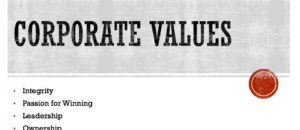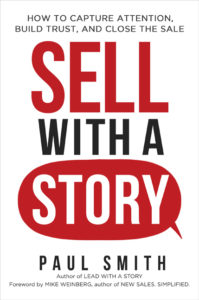Podcast: Play in new window | Download | Embed
Subscribe: RSS
Podcast (lead-with-a-story-podcast-series): Play in new window | Download | Embed
Subscribe: RSS
 Sometimes living up to your company’s values requires more than just knowing what the right thing is and wanting to do it. In those cases, a little creativity sometimes helps. Here’s an example that will hopefully give you some ideas for how to respond when you’re in your own pickle of a situation.
Sometimes living up to your company’s values requires more than just knowing what the right thing is and wanting to do it. In those cases, a little creativity sometimes helps. Here’s an example that will hopefully give you some ideas for how to respond when you’re in your own pickle of a situation.
Martin Nuechtern is an Austrian who spent his final working years in the United Kingdom. After finishing his doctorate in business administration, he joined Procter & Gamble as an assistant brand manager. Twenty-seven years later, he retired as the president of one of the company’s global business units.
He was as disciplined about his personal life as he was about his work. At one point he had a sign on his office door that read, “I work from 8 A.M. to 6 P.M., Monday through Friday. Outside those hours, I am at home with my family.” The implied message was that outside those hours, you should be at home with your family, too, and not in the office working!
Part of his leadership philosophy is that “leaders should live the company values—visibly.” He argues that’s the best way to ensure the rest of the organization behaves the same way. “If you go out for expensive dinners and stay at fancy hotels on business trips, your people will too. If you go home at 3 P.M. every day, so will they.”
One time he was on a business trip to New York to meet with his advertising agency. One of the agency personnel invited Martin to the Metropolitan Opera. They knew he was a big fan. When in New York, he never missed a performance. But opera tickets can be expensive, especially good tickets. And these were very good tickets.
At P&G, gifts over $25 in value are not allowed by company policy. They have to be paid for by the recipient. But not every company has such a strict policy, so it’s not unusual for a set of show tickets to find their way into a client’s hands.
In this case, when Martin entered the theater with the account executive, he couldn’t see the ticket price. He asked several times, but the agency was deliberately evasive, determined to let Martin enjoy them as a gift. After he got home, Martin made a phone call to the opera house. He found out how much the tickets cost and asked if they had a “Friends of the Opera” organization that accepted charitable donations.
A week later, the account manager who gave him the tickets received an official-looking letter from the opera house. But it wasn’t addressed to her. It was addressed to her dog, Gilda. Inside the envelope was a membership card with the dog’s name on it, and a letter thanking Gilda for her generous gift to the arts. Martin had found a way to pay for the tickets anyway.
Every six months or so, Gilda gets a letter from the Met announcing the upcoming shows. Her owner gets a gentle and lighthearted reminder to stay out of the doghouse by doing the right thing. And Martin gets to chuckle when he tells this story to others as a reminder that doing the right thing isn’t always easy. But with a little creativity, it’s always possible.
 The overall lesson is that company values are determined not by what it says on your company values document buried in a file cabinet somewhere. They’re determined by the behavior of the people who work there, and the stories that capture that behavior.
The overall lesson is that company values are determined not by what it says on your company values document buried in a file cabinet somewhere. They’re determined by the behavior of the people who work there, and the stories that capture that behavior.
If you don’t have strong company value stories, then in the minds of your employees (where it matters most) you probably don’t have strong company values.
Here’s your homework:
A. Determine what your most important company value is.
While CEO of P&G, John Pepper was once asked in an interview which skill or characteristic was most important to look for when hiring new employees. Was it leadership? Analytical ability? Problem solving? Collaboration? Strategic thinking? Or something else? His answer was integrity. He explained, “All the rest, we can teach them after they get here.”
- Ask your leadership, “What are our most important company values?”
- Ask yourself, “What stories are currently being told about those values?”
- And, “Are those stories supporting the message you want them to?”
B. Find the best stories that support your most important values and share them
Having trouble thinking of value stories? Here’s some help. Think of times when you, or someone else in your company:
- Had to make a really tough choice
- Made a promise, and had trouble keeping it
- Had to get the company policy manual out to decide the right thing to do
- Had to ask for help from the human resources department or the company ethics officer
before making a difficult decision - Were asked to do something you didn’t feel good about
- Acted in a way that would have made the founder of your company proud
- Felt conflicted about two separate values
[You can find this and over 100 other inspiring leadership stories in my book, Lead with a Story.]
—
 Paul Smith is one of the world’s leading experts on business storytelling. He’s a keynote speaker, storytelling coach, and bestselling author of the books Lead with a Story, Parenting with a Story, and Sell with a Story.
Paul Smith is one of the world’s leading experts on business storytelling. He’s a keynote speaker, storytelling coach, and bestselling author of the books Lead with a Story, Parenting with a Story, and Sell with a Story.


 Connect with him via email here.
Connect with him via email here.
Follow him on Facebook, LinkedIn, Twitter, and Instagram.
Sign up for his newsletter here to get one new story a week delivered to your inbox.

